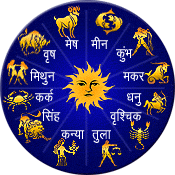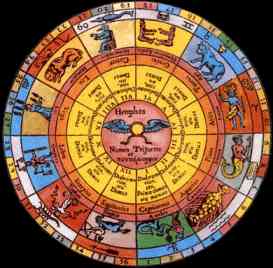22
MAR 2016
Indian Astrology- Astrologer Vinayak Bhatt
Quite naturally the man had been attempting to reveal the future since time immemorial. This lead to the development of different branches of astrology in all the corners of the world, such as Burmese system Ma Ha Bote, Western or English system, Indian or Hindu system of astrology.
AYANMSA OR PRECESSION OF EQUINOXES
English system includes ayanamsa, and hence also known as Sayana system. Indian system excludes ayanamsa, and hence known as Nirayana system. These two are the popularly known systems of astrology all over the world. Hindu lunar zodiac is fixed among the stars and the English lunar zodiac is movable among the stars. As a matter of fact, Vernal Equinox, the point of intersection between ecliptic and celestial equator where from the Sun enters the northern hemisphere, retrogrades along the ecliptic with an average velocity of one degree every seventy-two years. That is why Vaishakhi, the day of solar ingress into sidereal Aries, shifts a day ahead every seventy two years.
This would subsequently result into reversal of seasons after about 13000 years, thus causing Winter in June and Summer in December. In Hindu astrology, according to Chitrapakshiya School, the actual position of Vernal Equinox in 285 A.D. has been fixed and considered as the first point of Aries of fixed lunar zodiac of Hindus. Actually the Vernal Equinox is situated 43′ ahead of Mu Piscium star which is situated 180° apart from Alpha Virginis star of Chitra nakshatra. According to Raivatpakshiya School, Vernal Equinox coincides with the position of Zeta Piscium star of Ravati nakshatra.
According to Saura pakshiya School, it is situated 12′ ahead of its position according to Chitrapakshiya School. Similarly Krishnamurthi and Raman Schools of ayanamsa came into vogue merely for purposes of astrology and they have no astronomical bases at all. Calendar Reform Committee, a government body in 1955, also recommended for Chitra School of ayanamsa. The sayana longitudes less ayanamsa become nirayana longitudes of planets etc. Due to diversity of values of ayanamsa, a competent astrologer must make a mention of the school of ayanamsa used. Vernal Equinox is the zero point of lunar zodiac and the longitudes of planets are measured there from.
PANCHANGA (ZADKEL)
Indian astrology is based on panchanga comprising of tithi (lunar day)’ day, nakshatra (asterism), yoga (combination) and karana (half-lunar day). It is indispensable to know about panchanga. A lunar day is measured through difference of geocentric longitudes of the Moon and the Sun. Amavasya ends when the Moon and the Sun have the same geocentric longitude. When the difference of longitudes of the Moon and Sun becomes(12° first lunar day ends and so on. A lunar day corresponds to the time required for the Moon to relatively exceed her longitude by 12° over that of the Sun.
Since the lunar orbit is elliptical, so the relative velocity of the Moon to that of the Sun is not uniform. Hence the length of the lunar day is not constant but it varies from minimum value 20 hours 1.44 minutes to maximum value 1 day 2 hours 49.68 minutes. There is a nine and a half-year-cycle of variation of length of a lunar day.The ending moment of a lunar day is the same all over the world. The day is named after the lunar day prevalent at the time of sunrise. Due to difference of time between sunrises at two distant places, a festival associated with the lunar day prevalent at the time of sunrise is celebrated on different days in different areas.
There are seven days in number. In Vedic times, the days were called after the names of nakshatras 28 in number. Then the days were counted by ordinal numbers upto fifteen, the number of lunar days in a paksha of half a lunar month. In India, any reference to a seven days week has as yet not been found earlier than 484 A.D. A day according to English calendar measures from midnight to midnight but according to Indian astrological system it measures from sunrise to sunrise. The cycle of days beginning from Sunday to Saturday is merely the one-one association with the set of seven planets viz. the Sun, the Moon, Mars, Mercury, Jupiter, Venus and Saturday taken in order.
There are twenty eight nakshatras (aster-isms) astronomically with unequal amplitudes. But astrologically the lunar zodiac is divided into 27 equal parts, each part called a nakshatra. Every nakshatra is sub-divided into four quarters. Thus the lunar zodiac consists of 108 quarters or one-fourths of a nakshatra. Nine quarters make a sign. The time taken by the Sun to traverse over a sign or 30° of ecliptic corresponds to a Hindu month or a sidereal month.
The day of solar ingress into a sign is called Sankranti. Vaishakhi or the day of solar .ingress to Aries is very significant as the Sun enters the northern hemisphere on this day. Similarly Maghi or the day of solar ingress into Capricorn is also very significant as the Sun starts its northern journey on this day. Moreover this is the day when the Sun points towards the direction in which the solar system appears to move with a velocity of 40 miles per second in the heavens.
Ecliptic or the apparent solar path among the stars is elliptical resulting mat the geocentric velocity of the Sun is non-uniform. Hence length of the sidereal months is not the same. They measure differently even in number of days. The asterism occupied by the Moon at the time of birth of a child is known as janma nakshatra or birth constellation. According to flora Cnarts, the child is named after the letter .associated with the quarter of the birth constellation. The sign occupied by the Moon at the time of birth is called the janma rashi or or birth sign of the. native.
There are 27 yoga’s (combinations) counting from Viskambha to Yaidhriti. The first yoga ends when the sum of longitudes of the Sun and the Moon becomes 13°20′ and the last yoga commences from 346°40′ to 360° as the sum of longitudes of the Moon and the Sun.
A lunar day is divided into two equal parts called karanas. There are four fixed karanas commencing once in a lunar month. There are seven moveable karanas which repeat themselves in a cycle. Vishti karana is also called Bhadra.
STATUS OF RAHU-KETU AS PLANETS
Technically planets are the heavenly bodies revolving around the Sun. But in Indian astrology, even a satellite like the Moon is also considered as a planet. Rahu and Ketu are also given the status of planets. Astronomically Rahu and Ketu keeping always 180° apart from each other are the two points of intersection between ecliptic and the lunar orbit. There are several other mathematical points like Gulika, Mandi, lndra, Parivesha and Dhumaketu etc.. ate called as sub-planets. The lunar orbit is inclined at an angel of 5°27’ to the ecliptic. Ordinarily the Sun, the Moon and the Earth are all in a line on every moon- day and full-moon-day but if the moon and the Sun are in the vicinity of Rahu and Ketu, they all fall almost in the same plane also and there occurs an eclipse lunar or solar. People generally say that Rahu-Ketu have swallowed the Sun or the Moon as the eclipse is solar or lunar.
BRANCHES OF ASTROLOGY
There are several branches of astrology some of which are mentioned in brief as under:
Natal Astrology
It deals with horoscopy. The general life sketch of an individual is estimated from his or her horoscope prepared on the basis of planetary longitudes at the time of birth. Female nativity is different from male nativity so far as interpretation of the horoscope is concerned. There arc two systems viz. Parashar system and Jaimini system which are most prevalent among the astrologers. The time of any event in life is determined through different systems of directional periods viz. Vimshottari, Ashtotari, Yogini and Kalachakra etc. Vimshottari, is most popular. According to Vimshottari, the maximum life span is estimated to be 120 years. The directional period is determined on the basis of birth nakshatra. There are twelve houses of the horoscope.
In northern India houses are fixed and the signs are moved whereas in southern India signs are fixed and the houses are movable. Tajaka Astrology It deals with varshaphala or annual prediction. A new year begins when the Sun reaches its radical position or attains the longitude equal to that at the time of birth. The length of the year is also not constant. Table of varshaphalas is based on average length of the year. A new born child enters into the second year when he attains an age of 365 days 6 hours 15 minutes and 9 seconds. Varshaphala is subject to the natal chart.
Auspicious Day
It deals scientifically with election of auspicious day and time for commencing some work. Mundane Astrology
It deals with political, economic, social, agricultural and such miscellaneous influences of planetary movements. It also deals with rise and fall of prices of commodities.
Omenology
Samhita texts, a class of literature, deal with prediction through natural indications, uncommon phenomenon and omens.
Nadi Astrology
There are several nadi texts like Bhrigu Samhita, which deal with interpretations of natal charts even a few centuries in advance. A nadi text describes interpretations of 150 sub-parts of a degree of arc. In this way 360° correspond to 54900 sub-parts. It indicates that the nadi text deals with 54900 classes of personalities.
Indian Astrology- Astrologer Vinayak Bhatt
Read Navaratri Special Article


